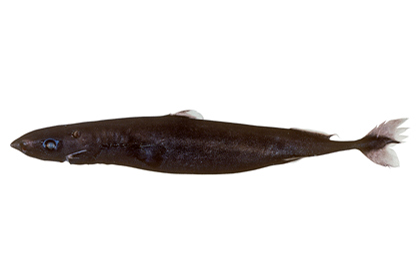Smalleye Pygmy Shark, Squaliolus aliae Teng 1959

A Smalleye Pygmy Shark, Squaliolus aliae. Source: Australian National Fish Collection, CSIRO. License: CC BY Attribution-Noncommercial
A dwarf pelagic shark - possibly the smallest living shark - with thousands of tiny photophores covering the lower surface. The Smalleye Pygmy Shark inhabits the oceanic 'twilight' zone, and produces bioluminescence to hide its silhouette from upward-looking predators.
Smalleye Pygmy Shark, Squaliolus aliae Teng 1959
More Info
|
Distribution |
Known on Australian waters from the Northwest Shelf, Western Australia, the Coral Sea, off central and southern QLD (26º21-31'S) and off Sydney, New South Wales. The species is a wide-ranging epipelagic, mesopelagic, and bathypelagic shark over the continental slopes near land masses in the Eastern Indian and western Pacific oceans, mostly at depths between 200-2000 m. The Smalleye Pygmy Shark is thought to undertake daily vertical migrations to feed at shallower depths at night, returning to 'hide' in deeper waters during the day. The species uses bioluminescence to provide counter-shading in epipelagic and mesopelagic waters. |
|
Features |
Characters: first dorsal fin closer to pectoral than pelvic fin; first dorsal-fin spine present, second dorsal-fin spine absent;snout pointed; upper and lower caudal-fin lobes almost symmetrical; second dorsal fin long-based, about twice length of base of first dorsal fin. |
|
Size |
Possibly the smallest living shark, with a maximum total length of about 22 cm; males mature at about 15 cm TL, females between 17 and 20 cm TL. |
|
Feeding |
Carnivore - feeds mostly on small midwater fishes (such as lanternfishes) and invertebrates (such as cephalopods, krill and shrimps). |
|
Biology |
Very little is known of the biology of this species. Like all sharks and rays, the sexes are separate and fertilisation is internal. Females are aplacental viviparous (ovoviviparous) meaning that the embryos develop inside eggs which hatch within the uterus. Litter size is unknown, and size at birth is less than 10 cm TL. The undersides of Smalleye Pygmy Sharks are covered in tiny photophores used for camouflage by hiding the shark's silhouette. The sharks control the amount of light emitted by adjusting the pigmentation in cells covering the photophores - more pigment, less light. |
|
Conservation |
IUCN Red List: Least Concern |
|
Remarks |
Studies have shown that the bioluminescence is controlled by the hormone melatonin and a neurotransmitter. The shark switches the light 'on' using melatonin, and the neurotransmitter GABA gradually 'turns off' the light. |
|
Etymology |
The species is named alii for the wife of one of the authors. |
|
Species Citation |
Squaliolus alii Teng, 1959, Report - Laboratory of Fishery Biology, Taiwan Fisheries Research Institute 8: 1, pl. 1. Type locality: off Tungkong, Kao-Hsiung Pref., Taiwan. |
|
Author |
Bray, D.J. 2016 |
Smalleye Pygmy Shark, Squaliolus aliae Teng 1959
References
Claes, J.M., Ho, H.-C. & Mallefet, J. 2012. Control of luminescence from pygmy shark (Squaliolus aliae) photophores. J. Exp. Biol. 215: 1691-1699. PDF
Claes, J.M., D.-E. Nilsson, N. Straube, S.P. Collin & J. Mallefet. 2014. Iso-luminance counterillumination drove bioluminescent shark radiation. Scientific Reports 4(4328) doi:10.1038/srep04328
Claes JM, Partridge JC, Hart NS, Garza-Gisholt E, Ho H-C, et al. 2014. Photon Hunting in the Twilight Zone: Visual Features of Mesopelagic Bioluminescent Sharks. PLoS ONE 9(8): e104213. doi:10.1371/journal.pone.0104213
Compagno, L.J.V. 1984. FAO Species Catalogue. Sharks of the World. An annotated and illustrated catalogue of shark species known to date. Hexanchiformes to Lamniformes. FAO Fisheries Synopsis No. 125. Rome : FAO Vol. 4(1) pp. 1-249 (p. 108, in part as Squaliolus laticaudus)
Compagno, L.J.V. & Niem, V.H. 1998. Hexanchidae, Echinorhinidae, Squalidae. pp. 1208-1232 in Carpenter, K.E. & Niem, V.H. (eds) The Living Marine Resources of the Western Central Pacific. FAO Species Identification Guide for Fisheries Purposes. Rome : FAO Vol. 2 687-1396 pp.
Compagno, L.J.V., Dando, M. & Fowler, S. 2005. A Field Guide to the Sharks of the World. London : Collins 368 pp.
Digital Fish Library Team Squaliolus aliae (Smalleye Pygmy Shark) http://www.digitalfishlibrary.org/ Accessed 23 January 2017.
Ebert, D.A., Fowler, S. & Compagno, L. 2013. Sharks of the World. Wild Nature Press, Plymouth.
Kyne, P.M. & Heupel, M.R. 2015. Squaliolus aliae. The IUCN Red List of Threatened Species 2015: e.T41858A68643995. http://dx.doi.org/10.2305/IUCN.UK.2015-4.RLTS.T41858A68643995.en. Downloaded on 23 January 2017.
Kyne, P.M., Johnson, J.W., Courtney, A.J. & Bennett, M.B. 2005. New biogeographical information on Queensland chrondrichthyans. Memoirs of the Queensland Museum 50(2): 321-327.
Last, P.R. & Stevens, J.D. 1994. Sharks and Rays of Australia. Canberra : CSIRO Australia 513 pp. 84 pls
Last, P.R. & Stevens, J.D. 2009. Sharks and Rays of Australia. Collingwood : CSIRO Publishing Australia Edn 2, 550 pp.
Sasaki, K. & Uyeno, T. 1987. Squaliolus aliae, a dalatiid shark distinct from S. laticaudus. Japanese Journal of Ichthyology 34(3): 373-376.
Seigel, J.A. 1978. Revision of the dalatiid shark genus Squaliolus: anatomy, systematics, ecology. Copeia 1978: 602–614.
Seigel, J.A., Pietsch, T.W., Robison, B.H. & Abe. T. 1977. Squaliolus sarmenti and S. alii synonyms of the dwarf deepsea shark, Squaliolus laticaudus. Copeia 1977(4): 788-791.
Digital Fish Library Team Squaliolus aliae (Smalleye Pygmy Shark) Accessed 23 January 2017.
Tanakamaru H., Shibuya T. & Kubota T. 1999. Some Biological Aspects of the Spined Pygmy Shark, Squaliolus aliae, from Suruga Bay, Japan. Journal of the Faculty of Marine Science and Technology, Tokai University 48: 51–67.
Teng, H.T. 1959. Studeis [sic] on the elasmobranch fishes from Formosa. Pt. 4. Squaliolus alii, a new species of deep sea squaloid shark from Tung-Kang, Formosa. Report – Laboratory of Fishery Biology, Taiwan Fisheries Research Institute 8: 1–6.





